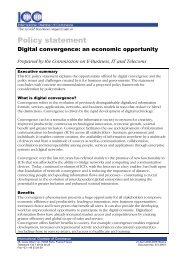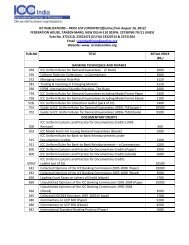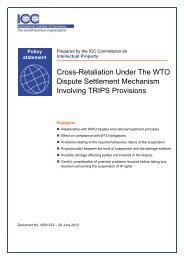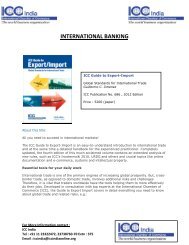2013 - ICC India
2013 - ICC India
2013 - ICC India
- No tags were found...
You also want an ePaper? Increase the reach of your titles
YUMPU automatically turns print PDFs into web optimized ePapers that Google loves.
58<strong>ICC</strong> BANKING COMMISSION | <strong>2013</strong> GLOBAL RISKS TRADE FINANCE | APPENDIX BThere are a couple of other issues that need to be considered whendetermining LGD. Firstly, given the specific nature of the RWA formulae,the LGD is expressed as a percentage of the EAD, i.e. as a proportion of thedefaulting amounts rather than of the whole portfolio. Secondly, the LGDshould be based on the “default-weighted average” 123 (where each defaultedexposure has equal “weight”) rather than an “exposure-weighted average”(where the impact if a default on the average is based on the amount ofthe defaulted exposure). Unfortunately we only have aggregated data forindividual banks and are therefore unable to derive a default-weightedfigure at this stage.Sensitivity of recoveries to treatment of “missing” dataIn order to estimate losses on defaulted cases, we need to know the amountof exposure which defaulted, the amount of exposure that was recoveredor written-off and the timing of recoveries. As well as this, we would ideallyhave information on completed workout cases so that all the defaultingexposure has either been recovered or written off. However, historicallythis information has not always been captured and, in addition, as firmsoften work out exposures for defaulted customers on an aggregate basis,systems do not always enable firms to explicitly link recoveries or writeoffsto a specific transaction. As a result, the amount of information thatparticipating banks have been able to provide varies:Lack of defaulted exposure information – in some cases, while we mayknow the number of defaults in a year, we do not necessarily know theamount of exposure which defaulted, so we cannot estimate a loss rate andhave had to exclude the observations.No information available beyond defaulted exposure – in some casesalthough defaulted exposure over the year is reported, no recoveries orwrite-offs are reported, so we have excluded these as we do not feel weknow the outcome of these defaults.Incomplete cases – in some cases, banks have only been able to provideinformation on recoveries on defaults in the year of the default but not insubsequent years. In these cases we have assumed the recoveries in thatyear as the best estimate of the total eventual recoveries. This is a prudentapproach, as we would expect recoveries on defaults that happen later inthe year to occur in the next calendar year, and the impact of changing thisassumption on the recovery rate can be seen in the table below.Only write-offs reported – where this is the case, in our base estimates,we have assumed that there were zero recoveries, which is likely a prudentassumption 124 . The impact on the recovery rate of assuming that banksrecovered everything that was not written off is shown in the table below.Multi-year data – some firms have reported defaulted exposure during theyear, as well as recoveries, write-offs and defaulted exposures at year-end.This has allowed the development of losses to be followed, except for minordifferences due to exchange rate effects. Given a long enough or stable timeseries of data, the total recoveries divided by the total defaulting exposurewould provide a reasonable estimate of the recovery rate. However, as notedabove, there are some cases in our dataset where the sum of recoveries andwrite-offs across multiple years does not equal the total defaulting exposureand in some cases exceeds it 125 . In our core approach we have again onlyrecognised reported recoveries, even if there are still incomplete cases. Thismeans capping maximum recoveries at the total defaulted exposure in ayear. The impact of an alternative assumption is shown in the table below.











